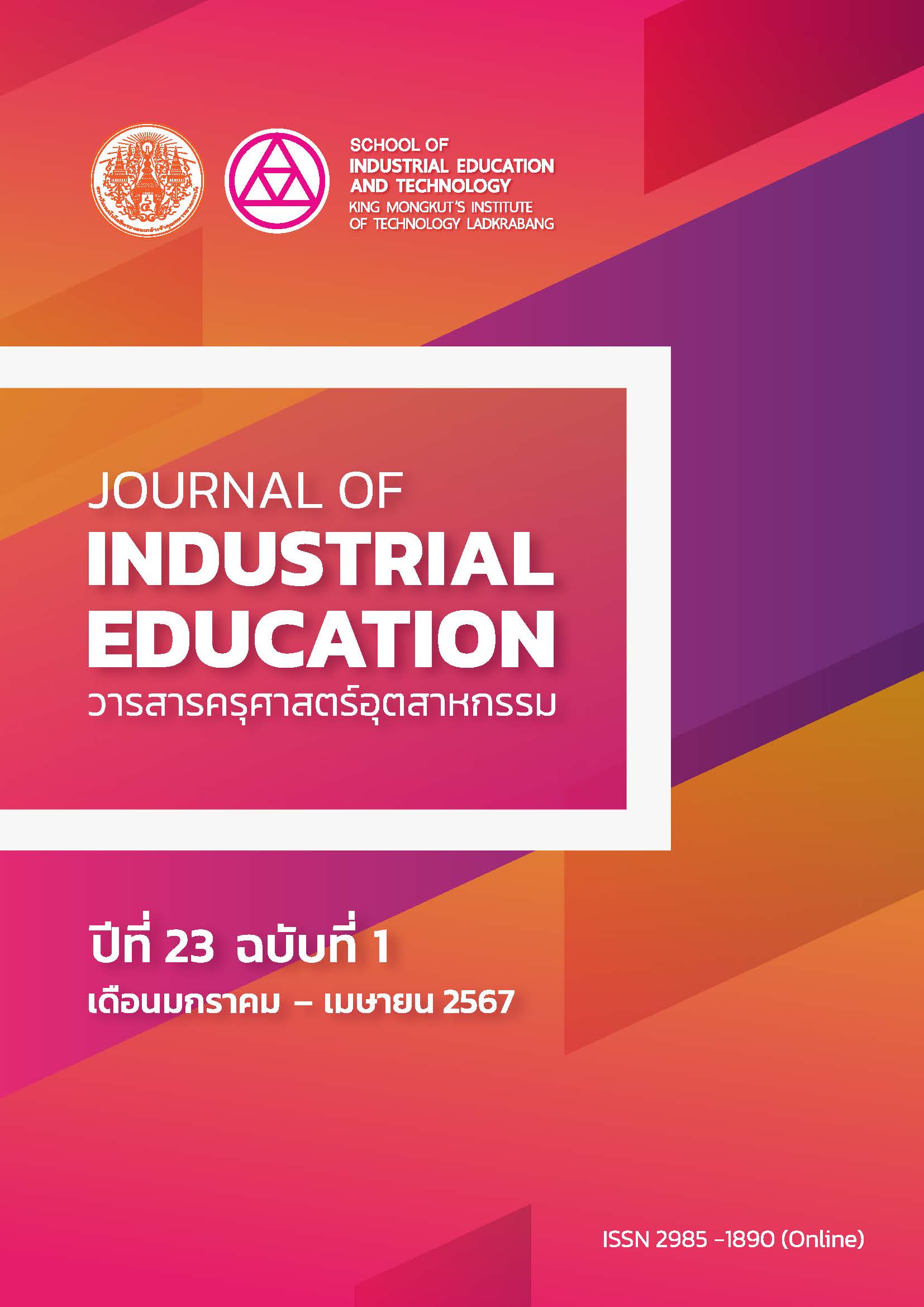COMPARISON OF LEARNING OUTCOMES ON 7 QC TOOLS BETWEEN UNDERGRADUATE STUDENTS STUDYING WITH BLENDED LEARNING AND TRADITIONAL LEARNING
Main Article Content
Abstract
This research is to compare learning outcomes in the areas of numerical analysis skills, communication skills, and information technology skills between undergraduate students studying with blended learning and traditional learning in the context of the course "Quality Control Tools" (Course code: IET.343). The focus is on the seven quality control tools, examining the effectiveness of blended learning in enhancing students' proficiency in these areas. The population is second-year student in the Faculty of Engineering, Department of Industrial Engineering Technology, a total of 125 students. The sample group consisted of 40 second-year students in the Faculty of Engineering, Department of Industrial Engineering Technology, who were enrolled in the course IET. 343 Quality Control, Semester 2/2020, which were obtained through purposive sampling. The sample group was divided into two groups: an experimental group and a control group. Then, 20 people were randomly assigned to the experimental group and 20 people to the control group by simple lottery method. Each learning is evaluated based on numerical analytic thinking skills, communication skills, and the use of information technology skills test. The statistics employed in this research were mean (), standard deviation (SD), and F-test (One-Way MANOVA). The findings indicated that the blended learning group, which includes the average scores for numerical analysis skills (16.70), communication skills (10.65), and information technology usage skills (9.40), performed better scores than the traditional learning group. The traditional learning group had average scores for numerical analysis skills, communication skills, and information technology usage skills at 13.40, 9.10, and 8.20, respectively. These differences are statistically significant at the .01 level.
Article Details

This work is licensed under a Creative Commons Attribution-NonCommercial-NoDerivatives 4.0 International License.
"The opinions and contents including the words in papers are responsibility by the authors."
"ข้อคิดเห็น เนื้อหา รวมทั้งการใช้ภาษาในบทความถือเป็นความรับผิดชอบของผู้เขียน"
References
Allen, I. E., Seaman, J., & Garrett, R. (2007). Blending in: The extent and promise of blended education in the United States. Sloan Consortium.
Almarzooq, Z. I., Lopes, M., & Kochar, A. (2020). Virtual learning during the COVID-19 pandemic: A disruptive technology in graduate medical education. Journal of the American College of Cardiology, 75(20), 2635-2638.
Bangkokbiznews. (2020, June 19). COVID-19 accelerate study for Thailand, it's time to change? https://www.bangkokbiznews.com/news/detail/885550. (in Thai)
Capone, R., De Caterina, P., & Mazza, G. A. G. (2017, July 3). Blended learning, flipped classroom and virtual environment: Challenges and opportunities for the 21st century students. In L. G. Chova, A. L. Martínez, & I. C. Torres (Eds.), Edulearn17 Proceedings 2017: 9th International Conference on Education and New Learning Technologies (pp. 10478-10482). IATED.
Chaisomtrakul, P., & Wilaikul, S. (2019). A comparative study of learning outcomes bachelor’s degree standard in accounting with international education standard for professional accountant. Academic Journal of North Bangkok, 6(3), 87-100. (in Thai)
Curriculum Committee Department of Industrial Engineering Technology. (2020). Course performance report: Bachelor of Industrial Technology Department of Industrial Engineering Technology academic year 2019. Kasem Bundit University. (in Thai)
Industrial Engineering Technology. (2023). Course performance report: Bachelor of industrial technology department of industrial engineering technology academic year 2022. Kasem Bundit University. (in Thai)
Giannakos, M., Chorianopoulos, K., Ronchetti, M., Szegedi, P., & Teasley, S. (2014). Video-based learning and open online courses. International Journal: Emerging Technologies in Learning, 9(1), 4-7.
Hair, J. F., Black, W. C., Babin, B. J., Anderson, R. E., & Tatham, R. L. (2006). Multivariate data analysis (6th ed). Pearson Prentice-Hall.
Hiangrat, P., Sacchanand, C., & Choempayong, S. (2018). Information literacy of undergraduate students of Rajabhat Universities. TLA Research Journal, 11(1), 33-47. (in Thai)
Irawan, E., Ahmadi, A., Prianggono, A., Saputro, A. D., & Rachmadhani, M. S. (2020). YouTube channel development on education: Virtual learning solutions during the Covid. International Journal of Advanced Science and Technology, 29(4), 2469-2478.
Istenič, A. (2021). Online learning under COVID-19: Re-examining the prominence of video-based and text-based feedback. Educational Technology Research and Development, 69, 117-121.
Ittichinnapat, J., Piromjitpong, S., & Sawadthaisong, N. (2016). The research-based learning model into development preferable numerical analysis skills, communication and information technology skills faculty of bachelor’s degree for Rajabhat Institute instructors. NRRU Community Research Journal, 10(3), 142-153. (in Thai)
Ljubojevic, M., Vaskovic, V., Stankovic, S., & Vaskovic, J. (2014). Using supplementary video in multimedia instruction as a teaching tool to increase efficiency of learning and quality of experience. The International Review of Research in Open and Distributed Learning, 15(3), 275-291.
Majid, S., Khine, W. K. K., Oo, M. Z. C., & Lwin, Z. M. (2012). An analysis of YouTube videos for teaching information literacy skills. Advanced Information Technology in Education, 126, 143-151.
National Electronics and Computer Technology Center (NECTEC). (2002). Thailand Information and Communication Technology (ICT) master plan (2002-2006). Author. (in Thai)
Office of the Higher Education Commission. (2004). Long-term higher education plan 20 Years (2018-2037). Bureau of Higher Education Policy and Planning. (in Thai)
Phakakat, S., & Sovajassatakul, T. (2020). Effects of copper model in blended service learning for the enhancement of undergraduate academic achievements and critical thinking. TEM Journal, 9(2), 814-819.
Jeyaraj, J. S. (2017). Blended learning VS. flipped classroom: Strength and weaknesses. In K. H. S. Zuhri (Ed.), Conference English Language Teaching: A Blended Approach (pp. 1-9). SVA Government Degree College, Sri Kalahasti, Andra Pradesh, India.
Sinaga, J. T. (2020). The effect of blended learning model to critical thinking and creative thinking skill students in senior high school [Doctoral dissertation]. Universitas Negeri Medan (UNIMED).
Tantranont, K., Tuanrat, W., & Kaewthummanukul, T. (2018). The application of blended learning approach to a epidemiology course. Nursing Journal, 45(1), 100-109. (in Thai)
Thaipost. (2020). Handing 5 new policies of the commissioner for education "Mor Udom" to take action. https://www.thaipost.net/main/detail/63124. (in Thai)
The Peak Performance Center. (2020). Analytic thinking and critical thinking. https://thepeakperformancecenter.com/educational-learning/thinking/critical-thinking/analytical-thinking-critical-thinking.
Tuaycharoen, N. (2021). University-wide online learning during COVID-19: From policy to practice. International Journal of Interactive Mobile Technologies (iJIM), 15(2), 38-54.

